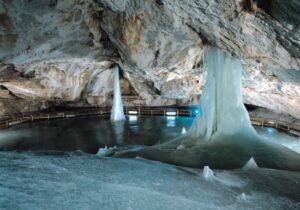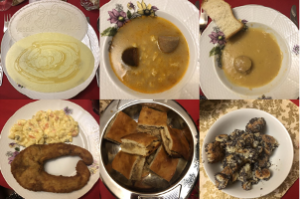

Discover the beauty and tourism of Slovakia!
Travel Story by Klara Geffertova
Slovakia, formerly known as Czechoslovakia, is a nation in Central Europe with 5.7 million residents. The Czech Republic, Poland, and Germany account for the majority of its visitors. This relatively tiny country has a wide variety of intriguing locations, from scenic natural areas to traditional old cities with a rich history and culture.
With more than 6 million visitors in 2019 and around 2.6 million in 2021, Slovakia’s tourism industry is ranked the 35th in the world overall. However, Slovakia and its attractions have a great potential to boost more visitors in the future.
One of the most intriguing facts is that Slovakia, with more than 180 castles and 425 châteaux, has the most castles per person worldwide. The most well-known castles include those in Bojnice, Bratislava, Devin, Orava, Beckov, Oravský Podzámok, and Spiš, which is one of the biggest in all of Europe. Numerous stories are also attached to several of them, the most well-known of which is the one about the bloodthirsty countess Elizabeth Bátory at Čachtice Castle. A more than 400-year-old legend about Bátory describes how she murdered several girls, particularly young ones. Nobody could fathom her source of such rage and malice. Although young Elizabeth was remarkably beautiful, she was also aggressive and cruel. She got worse as she grew older. She was furious because her attractiveness and beauty was fading away. Her maid once unintentionally tugged her hair while combing it. She scraped at her face till it started to bleed. On her hand, one drop of blood dried. She noticed that after washing it, her skin appeared to somehow become younger. Elizabeth then began abusing girls before bathing in their blood. The royal judge lost patience with Elizabeth and had her walled up in the Čachtice Castle.
 https://bojnicecastle.sk/ |
 https://www.teraz.sk/slovenski-demoni-a-strasidla/krvava-grofka/226899-clanok.html |
In addition to castles, the number of caves in Slovakia are higher than those found elsewhere in Europe. Twenty of the more than 7,500 recognized caves in the nation can be visited. Most beautiful caves include Demanovska Ice Cave, Demanovska Cave of Liberty, Dobšinská Ice Cave, Bystrianska Cave, Belianska Cave, Harmanecka Cave, Domica Cave, Gombasecka Cave, Jasovska Cave, and Ochtinska Aragonit Cave.
Ochtinska Aragonit Cave is one of only three aragonite caves in the world (two others are in Mexico and Argentina). The cave was discovered in 1954, and it was made accessible to the public in 1972. The temperature within the cave, which is 642 meters above sea level, ranges from 7.2 to 7.8°C. The ornate aragonite formations are made by the stable microclimate, dissolved iron, manganese, and magnesium ions, as well as the slowly dropping water. These formations range in age from 120,000 to 130,000 years old, with younger formations dating to around 14,000 years. Aragonite is a carbonate mineral and one of the three most prevalent naturally occurring crystal forms of calcium carbonate. It is created as a result of biological and physical processes, such as precipitation from freshwater and marine habitats.
 https://www.slovakia.com/sk/jaskyne/ochtinska-aragonitova-jaskyna/ |
 https://www.quark.sk/jedinecny-podzemny-ladovec/ |
Tourists can enjoy the beauty of nature in 9 national parks, including High Tatras, Low Tatras, Slovenský Raj, Slovenský Kras, Malá Fatra, Veľká Fatra, Muránska Planina, Poloniny and Pieniny at the border with Poland, offering traditional rafting on the Dunajec River.
For all skiers and snowboarders, Slovakia is the optimal destination. You can anticipate 457 kilometres of skiing slopes in Slovakia, among which the most popular are Ski Park Jasná in Low Tatras, Donovaly, Bachledka Ski and Sun, and Oravská Lesná.
Bachledova Dolina is well-known not only in the winter for its ski resort Bachledka Ski and Sun, but also year-round for its popular tourist attraction Chodník Korunami Stromov, a treetop walk bordering Pieniny and High Tatras National Parks. A gentle climb takes you to the treetops at a height of 24 meters, revealing why the local vegetation is so distinctive.

https://bachledka.sk/fotogaleria/chodnik-korunami-stromov-leto/chodnik-korunami-stromov-bachledka6
One of the most notable examples of a significant mining community that has grown since the Middle Ages is the Historic Town of Banská Štiavnica. This vast property, which is situated in the Štiavnické Vrchy Mountains, has a total area of 20,632 hectares and contains the city of Banská Štiavnica as well as the surrounding areas, which are home to significant artifacts from former mining and metallurgical operations, particularly those involving gold and silver. Even though mining has been documented as far back as the late Bronze Age, Banská Štiavnica is the oldest mining town in Slovakia which was officially founded in the 13th century.
Not far from Banská Štiavnica, you can find one of the world’s oldest mints, the Kremnica Mint, which was founded in 1328 by King Charles Robert of Anjou. The local mint has been producing coins for approximately 700 years. In the past, Kremnica ducats were highly valued for their high quality and were regarded as Central Europe’s hardest money. In addition to a unique tour of the ancient coins mint, Mint Kremnica has established a mint exhibition that allows a look at intriguing exhibits in the refurbished chambers of the historical structure of the Mint. The Kremnica Mint produces commemorative and circulation coins for the National Bank of Slovakia (Slovak euro coins), but due to its capacity and quality requirements, it is also exporting coins to other nations throughout the world. In the past, Kremnica has manufactured coins and investment/aid coinage for nations including Bangladesh, Thailand, India, and other countries in South Asia, and Latin America.
Slovakia is also popular among locals and foreigners for numerous spas and thermal baths with their mineral springs, among which the most popular are Bešeňová, Vrbov, Trenčianske Teplice, Turčianske Teplice, Rajecké Teplice, Lúčky, Kováčová, Dudince, Číž, Piešťany, Vyšné Ružbachy, and Bardejov Spa. Bardejov Spa is located five kilometers from my hometown of Bardejov, and its mineral springs, geographical location, and professional approach of staff members have beneficial effects on the treatment of diseases for both children and adults, especially oncological diseases, circulatory system diseases, digestive system diseases, women’s diseases (climacteric syndrome), kidney and urinary tract diseases, and mobility system diseases.

https://www.kupele-bj.sk/
Among others, tourists should definitely not miss the capital of Bratislava, water parks Meander Park Oravice, Vodný park Bešeňová, Tatralandia Liptovský Mikuláš and Aquapark Dolný Kubín or cities such as Košice, Banská Bystrica, Bardejov, Levoča, Čičmany, and Vlkolínec with its rich history in culture and folklore.
In addition to beautiful and historic tourist destinations, Slovakia also has a hidden gem in its inhabitants. Slovaks are very friendly and hospitable people who will offer their loved ones whatever they have. Not just among family members but also among friends and coworkers, frequent visits are quite popular, and the tables are always piled high with a wide variety of traditional foods. Bryndzové halušky, or in English dumplings with sheep cheese and fried bacon, are one of the most traditional foods in Slovakia.

Slovak folklore frequently draws on the country’s rich traditions to depict its culture. Folk traditions continue to be well received in the nation, from handicrafts to open-air markets and festivals to music and dance ensembles. Lace embroidery, beekeeping, sheep farming, pottery making, and woodcarving are examples of Slovak arts and crafts. Slovakia’s folklore is mostly passed from one generation to the next, with each area retaining its distinct character in terms of characteristic attire, rituals, dialects, and general aesthetic. Two reputable professional folk groups in Slovakia are Lúčnica and Sľuk.
The Východná Folkloric Festival, the Pod Poľana Folklore Festival in Detva, Jánošíkové Dni in Terchová and Myjava International Folk Festival are significant Slovak folkevents.

Several Slovak customs have a Christian connection and are observed at the most well-known Christian events. The most unique is the traditional Slovak Easter, when men splash cold water on women on Easter Monday to assure them of good health and beauty for the entire year. Carnivals at the start of the year, St. Nicholas Day, Epiphany, the burning of Morena, and traditional Christmas dinner with unique foods are some other traditions.
Morena is a symbol of winter and burning it an expression of longing for the end of cold weather and cold days. It is a huge doll that is usually carried on a stick by women during the procession and it takes place 2 weeks before the Easter.
Christmas traditions differ from region to region and the following ones are the common ones in our region of Šariš and our family. During the whole day on the 24th of December, we are all fasting and have a dinner together, usually at my grandparents’ house where the whole family meets. Traditional dinner includes an apple, wafers with honey, cabbage soup with mushrooms and sausage, lentil soup, potato pie, carp fish with potato mayonnaise salad, and bobaľky (sweet balls with poppy seeds). There dishes are usually not eaten during the year, and therefore they´re closely connected to Christmas dinner. After dinner we all enjoy time together at the Christmas tree by unpacking presents while listening to Christmas songs.

When visiting Slovakia, it is best to fly to one of the two most popular airports in Slovakia, M.R. Štefánik Airport in Bratislava or Košice Airport. Alternative option is also the arrival to nearby Vienna Airport and the subsequent transport to Bratislava, for example by Slovak Lines bus transport.
For more typical accommodation options in various wooden houses check https://www.megaubytovanie.sk/.
Do you wish to experience Slovakia with a local tour guide, learn more about the country from the first hand or need help with accommodation? Contact Stenli, a great friend of Charlotte by email on stenli.717@gmail.com





Dit bericht heeft 0 reacties